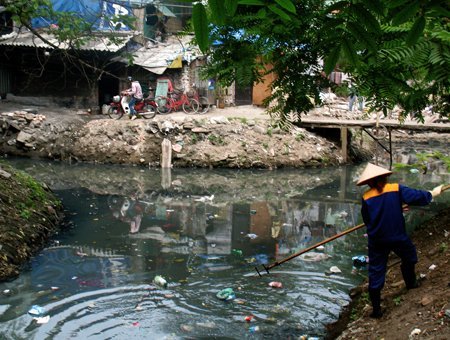There are nearly 200 rivers, lakes and other waterways in Hanoi, compared with the green lungs that helped bring fresh air to the capital city. However, with the urbanisation boom, the lungs have become no longer green.

The "black water village" in Hanoi
The natural garbage can
Except for some big lakes in the central area of Hanoi such as Hoan Kiem, West Lake, Thien Quang or Bay Mau, which have been rescued by very costly projects, a lot of other rivers, canals and lakes in Hanoi have fallen into terrible conditions.
The people living near the Dam Hong, Ha Dinh, Phuong Liet lakes in Thanh Xuan district, or Tam Trinh Lake in Hoang Mai district and Linh Quang lake in Dong Da district have fallen ill because they have to inhale the terrible smell risen from the lakes full of garbage, construction waste and black water.
Meanwhile, the people living along the Lang Road, where the To Lich river runs across, or on Kim Nguu and Kim Giang streets, where there is the Kim Nguu river, have suffered a constant anxiety that they would fall sick one day, because they have been living together with the pollution for the last many years.
In Ba Dinh district, a “black water village” has been taking shape and existing for the last 10 years. The village is the “confluence” of the two dirty canals in three wards of Kim Ma, Lieu Giai and Cong Vi. The waste water from local households and some workshops has been discharged to the canal which has turned dense and dark. The smell from the canal here is even more terrible than that on the Kim Nguu or To Lich rivers’ areas.
In 2011, the Center for Environment Community and Research CECR released a report, showing that only 2 percent of the rivers, lakes and ponds in Hanoi could meet the standards, while the others all had been seriously polluted.
Especially, CECR compared the polluted waterways as the natural garbage can with 90 percent of domestic waste discharged directly to the rivers and lakes.
People fear craft villages, dread industrial zones
According to Senior Lieutenant Colonel Le Van Tam, from the Hanoi Police, there are two main reasons that lead to the water resource pollution – the domestic waste water and industrial waste water.
“It’s nearly impossible to control domestic waste. And it’s also impossible to control the waste water from agencies, schools. Very few units have waste water treatment system of their own,” he said.
In 2011, the environment police, joining forces with local authorities, discovered and punished violators in 100 cases. It is estimated that concentrated waste treatment systems have not been set up in more than 60 percent of industrial zones. These include Sai Dong B, Quoc Oai, Noi Bai, Viet Ha and Thanh Oai.
Meanwhile, craft villages have also become a big environment polluter. The villages gather the households which carry out small scale business with low investment capital and do not have financial capability to build waste water treatment system. As a result, the waste water is directly discharged to the lakes and rivers.
The toxic industrial waste water, plus domestic waste, is gradually killing the surface water resources in the city. Environmentalists have warned that the Nhue River may become a second Kim Nguu or To Lich River, since it is getting dirtier in recent years, if the city does not take any actions to protect it.
In fact, Hanoi has spent a lot of money to clean the city’s environment. However, the money has been used only for some big lakes in the central area of the city.

Leave your comment on this story